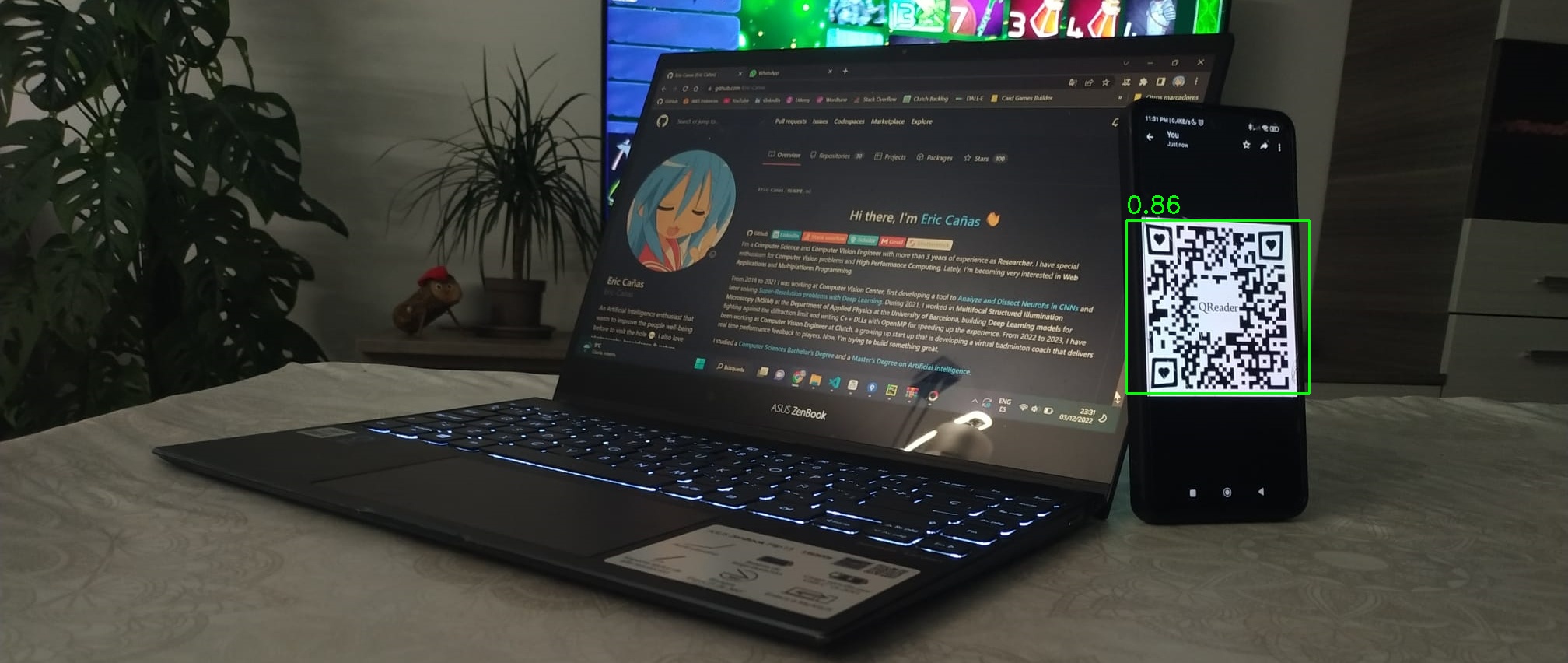Robust QR Detector based on YOLOv8
Project description
QRDet
QRDet is a robust QR Detector based on YOLOv8.
QRDet will detect & segment QR codes even in difficult positions or tricky images. If you are looking for a complete QR Detection + Decoding pipeline, take a look at QReader.
Installation
To install QRDet, simply run:
pip install qrdet
Usage
There is only one function you'll need to call to use QRDet, detect:
from qrdet import QRDetector
import cv2
detector = QRDetector(model_size='s')
image = cv2.imread(filename='resources/qreader_test_image.jpeg')
detections = detector.detect(image=image, is_bgr=True)
# Draw the detections
for detection in detections:
x1, y1, x2, y2 = detections['bbox_xyxy']
confidence = detections['confidence']
segmenation_xy = detections['quadrilateral_xy']
cv2.rectangle(image, (x1, y1), (x2, y2), color=(0, 255, 0), thickness=2)
cv2.putText(image, f'{confidence:.2f}', (x1, y1 - 10), fontFace=cv2.FONT_HERSHEY_SIMPLEX,
fontScale=1, color=(0, 255, 0), thickness=2)
# Save the results
cv2.imwrite(filename='resources/qreader_test_image_detections.jpeg', img=image)

API Reference
QReader.detect(image, is_bgr = False, **kwargs)
-
image: np.ndarray|'PIL.Image'|'torch.Tensor'|str.np.ndarrayof shape (H, W, 3),PIL.Image,Tensorof shape (1, 3, H, W), orpath/urlto the image to predict.'screen'for grabbing a screenshot. -
is_bgr: bool. IfTruethe image is expected to be in BGR. Otherwise, it will be expected to be RGB. Only used when image isnp.ndarrayortorch.tensor. Default:False -
legacy: bool. If sent as kwarg, will parse the output to make it identical to 1.x versions. Not Recommended. Default: False. -
Returns: tuple[dict[str, np.ndarray|float|tuple[float|int, float|int]]]. A tuple of dictionaries containing all the information of every detection. Contains the following keys.
| Key | Value Desc. | Value Type | Value Form |
|---|---|---|---|
confidence |
Detection confidence | float |
conf. |
bbox_xyxy |
Bounding box | np.ndarray (4) | [x1, y1, x2, y2] |
cxcy |
Center of bounding box | tuple[float, float] |
(x, y) |
wh |
Bounding box width and height | tuple[float, float] |
(w, h) |
polygon_xy |
Precise polygon that segments the QR | np.ndarray (N, 2) | [[x1, y1], [x2, y2], ...] |
quad_xy |
Four corners polygon that segments the QR | np.ndarray (4, 2) | [[x1, y1], ..., [x4, y4]] |
padded_quad_xy |
quad_xy padded to fully cover polygon_xy |
np.ndarray (4, 2) | [[x1, y1], ..., [x4, y4]] |
image_shape |
Shape of the input image | tuple[float, float] |
(h, w) |
NOTE:
- All
np.ndarrayvalues are of typenp.float32- All keys (except
confidenceandimage_shape) have a normalized ('n') version. For example,bbox_xyxyrepresents the bbox of the QR in image coordinates [[0., im_w], [0., im_h]], whilebbox_xyxyncontains the same bounding box in normalized coordinates [0., 1.].bbox_xyxy[n]andpolygon_xy[n]are clipped toimage_shape. You can use them for indexing without further management
Acknowledgements
This library is based on the following projects:
- YoloV8 model for Object Segmentation.
- QuadrilateralFitter for fitting 4 corners polygons from noisy segmentation outputs.
Project details
Release history Release notifications | RSS feed
Download files
Download the file for your platform. If you're not sure which to choose, learn more about installing packages.











